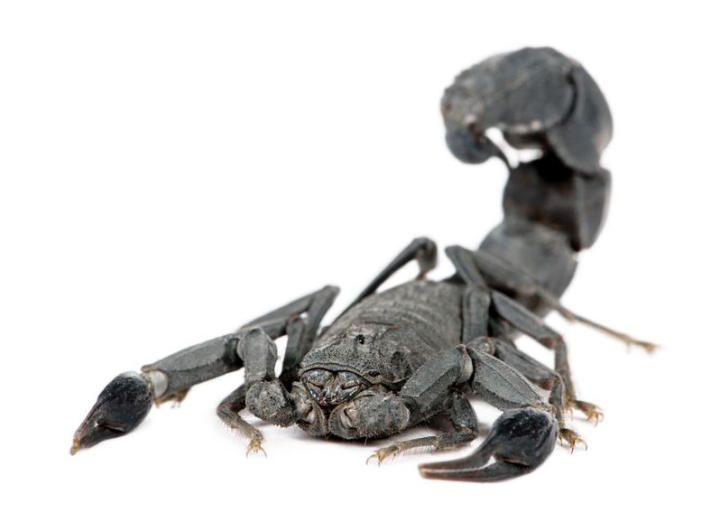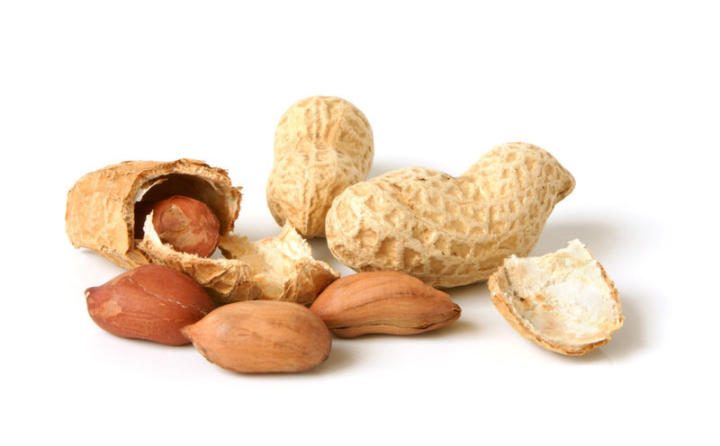If I was going to imagine the insect of nightmares it is definitely going to have the word “giant” in its name. And what could be worse than a giant hornet? The fact that it comes from Asia is neither here nor there, this is the biggest hornet in the world, a veritable wasp on steroids.
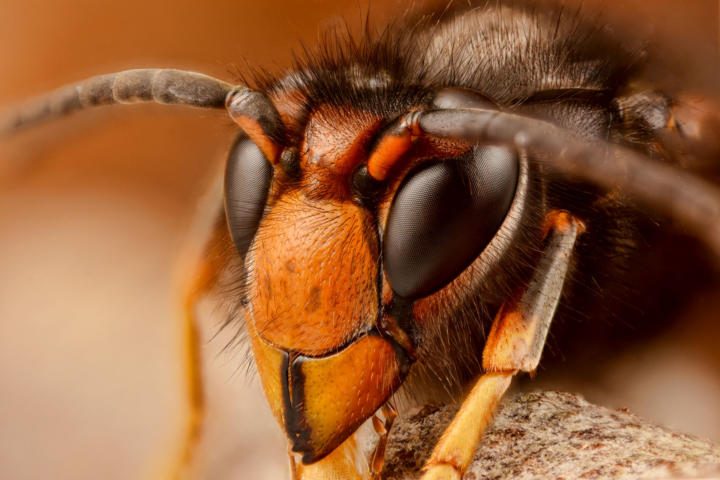
OK, so from the safety of your home some of you might feel bold enough to say that at 2 inch (5 cm) long the Asian giant hornet, armed with a ¼ inch (6mm) stinger, is not exactly giant. And while you may change that opinion if you were confronted by one in the flesh, we will concede that it isn’t exactly big enough to carry away grown men. So, in order to convey the true horror, and not overstate the case, Vespa mandarinia has been given the now commonly used moniker of the murder hornet.
Can a murder hornet kill you?
With names such as murder hornet, tiger head, yak killer or just plain old killer hornet this is a pretty fearsome sounding beast – but is it really that dangerous to humans? To some extent yes, it is and has earned that reputation over the years by causing numerous deaths.
In Japan between 20 and 50 people a year are killed by stings from giant hornets making it by far the deadliest animal in the country. In China the death toll is even higher with over 40 people killed and hundreds seriously injured by the hornets in one year in Shaanxi province alone. However, before we all panic, it is worth noting that the U.S. Centers for Disease Control and Prevention (CDC) estimate that around 60 people a year die in the United States from wasp, bee and hornet stings – although this is a combined number for all species.
To be fair to the giant hornet there is still no real scientific consensus on whether it is significantly more dangerous than a regular hornet. Yes, one-on-one these are probably the most dangerous of any wasp, bee or other hornet. But statistically they might not quite live up to their murderous reputation.
How bad is the sting?
How dangerous the murder hornet (or any stinging insect) is comes down to two factors; how powerful the venom is and how much is delivered. The hornet’s venom is made up of potent cocktail of cytotoxins and neurotoxins. It is the first of these that will cause all the pain and tissue damage with the sensation being described by one researcher as “like having a hot nail driven into my leg”. These cytotoxins also cause intense swelling and the breakdown of blood and muscle cells which are released into the blood. This can cause the further serious complication of renal failure as the kidneys try to filter out all the debris.
The neurotoxin contained in the venom give an added layer of danger to the effects of this hornet sting. Named mandaratoxin, it works by blocking nerve impulses but thankfully is not terribly strong. It is estimated that it would take around 200 stings to provide a lethal dose of the neurotoxin by itself. However, it is also believed to increase the possibility of an allergic reaction and anaphylactic shock.

While the venom itself may not be the strongest it is certainly incredibly painful. What the murder hornet sting in potency it more than makes up for in quantity and delivery. The 1/4 inch (6mm) stinger turns this beast into a flying syringe. For comparison a honey bee stinger is only about a quarter this length. This allows the hornet to penetrate most protective clothing and also deliver a massive dose. And because hornets don’t die after they sting they can do so more than once.
The general medical advice here is if you get stung 10 or more times you should seek medical help. Get stung more than 30 times and you are in big trouble, although to be honest you would probably realise this at the time!
As well as stinging its victims the giant hornet has also been reported to spray venom in some cases. One such attack in Japan left a person with permenant damage to their eyes, although there is little detail on the severity.
So, is it the most painful wasp sting?
According to entomologist Justin Schmidt the most painful insect sting of all is that of the Bullet ant. Ants are related to wasps but the most painful wasp sting Schmidt personally tested was that of the Tarantula Hawk wasp. He described this as: “Blinding, fierce, shockingly electric. A running hair drier has been dropped into your bubble bath”!
But there is another wasp that is said to have an even more excruciating sting. The quaintly named executioner wasp has a fearsome reputation throughout Latin America and while it is not considered aggressive, provoke it at your peril. One person who can attest to the severity of the sting is YouTuber Nathaniel “Coyote” Peterson who has allowed himself to be stung by some of the world’s nastiest insects. He ranked it up there with the Bullet ant and significantly worse than the murder hornet. Along with the initial pain and swelling he also reported some tissue necrosis with a “small hole” forming in his arm at the sting site.
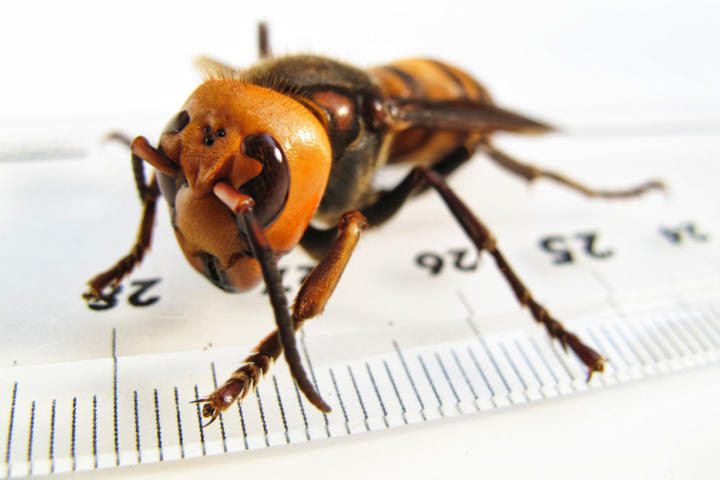
How big are the killer hornets?
The name giant hornet is probably enough to tell us that these are pretty big. We already know that hornets are super-sized wasps, and the murder hornet is the daddy of them all.
Let’s start with the headline figure that you may have seen elsewhere – however, please note this is for the queen. With a body length of nearly 2 inches (50mm) and a wingspan of 3 inches (75mm) these are the stuff of nightmare. Not only that, but they are capable of flying at speeds of up to 25 mph (40 km/h) – so there’s no escaping unless you can run like an olympic sprinter!
Admittedly the worker hornets are somewhat smaller at a mere 1.5 inches (40mm) but that is still pretty enormous for a a wasp.
How can you tell if it’s a murder hornet?
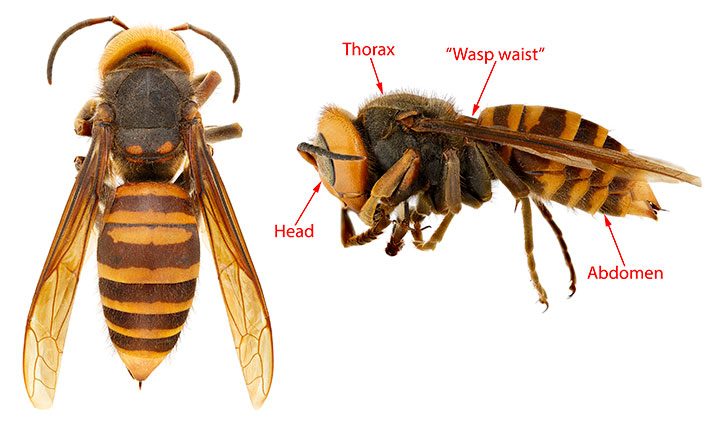
If you are lucky enough to see an Asian giant hornet the chances are you will be in Asia and it will look pretty big! Jokes aside they are reasonably easy to identify if you want to get close enough.
Along with all the usual hornet features such as narrow “wasp waist” and striped abdomen, the most notable feature is their large, bright orange head. In addition the stripes are generally towards the more orange end of the spectrum, as opposed to yellow.
There are a number of species that fairly closely resemble these hornets. If you are outside of Asia then the chances are it is one of several native look-alikes. These include the Eastern cicada killer wasp, which is a similar size and has some orange markings, and the elm sawfly, another large wasp. Closer relatives are the European hornet and Asian hornet, but neither of these match the size of the murder hornet.
Where do murder hornets live?
The names Asian or Japanese giant hornet are something of a clue, and generally it is the case that the murder hornet is only found in Asia. They are found in China, India, Japan, eastern Russia, Korea, Sri Lanka, Bhutan, Nepal, Myanmar, Thailand, Laos, Vietnam, Malaysia, Malaya, Hong Kong, and Taiwan. Here they inhabit forested, low mountainous regions.
The hornets nearly always nest underground in the discarded burrows of other animals or cavities between tree roots. They do however occasionally nest in trees. In general the nest can become quite large, supporting in excess of 1,000 workers, although a population in the hundreds is more common.
Are there killer hornets in America?
Actually there have always been killer hornets in America – native species cause a number of deaths every year. But has the murder hornet reached America?
Over the last couple of years there have been a handful of sightings in the Pacific Northwest and a number of nests have been destroyed. The first confirmed case involved 3 hornets being spotted on Vancouver Island in Canada in August 2019. They were tracked back to a nest which was destroyed. It wasn’t long before further sightings were made just over the border in the U.S. state of Washington. Alarmingly genetic analysis of the collected specimens revealed they had different origins with some coming from Japan and others South Korea.
Perhaps the most publicised case to date was in Blaine, Washington where a nest containing 98 hornets was destroyed with a vacuum hose. At present the Washington State Department of Agriculture is encouraging people to report any giant Asian hornet sightings through a website in the hope that this will prevent the further spread of the species. However, current projections suggest they could easily spread southwards to Oregon and north to British Columbia.
What do they prey on?
The murder hornet feeds on a wide range of insects such as mantises and even other hornets, including their own species. Perhaps the best-known prey though are honey bees. Murder hornets have been observed devastating bee colonies by decapitating them with their powerful jaws. The hornets are around five times the size of the bees and their thick armor makes them more or less invincible. In these hive raids individual hornets have been known to kill around 40 bees per minute in what is referred to as the “slaughter phase”. Just a handful of giant hornets can wipe out a bee colony in less than an hour.
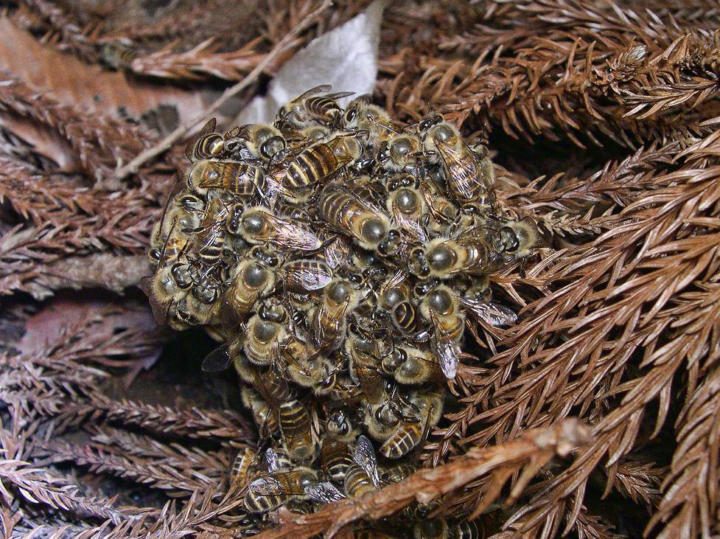
It might sound a little one-sided for the honey-bees, and this is the case with western honey bees (Apis mellifera). These were introduced into Japan as they produce more honey. However, native Japanese honey bees have a unique method of dealing with the attacking hornets. When a hornet enters the nest the bees quicky form a ball of up to a 100 around the invader. They then begin to violently vibrate their flight muscles which generates both heat and high levels of CO2 within the ball. Reaching 115 °F (46 °C) in the center, the CO2 levels become too high for the hornet, which dies, but the bees can tolerate it.
For this method to be effective it has to be used on the scout hornet before it can summon further reinforcements to decimate the hive.
Besides this the murder hornet has very few natural enemies. Basically nothing wants to mess with these super-wasps. That said, this being Asia, they do end up on the menu in some places. In some parts of Japan the hornet grubs are considered a delicacy when fried, whilst adults may occasionally be fried on a skewer and eaten when crunchy. There are also various alcoholic drinks such as “shochu” where a hornet is drowned in clear liquor before being left for a few years to mature. Perhaps the weirdest of all is an energy drink known as VAAM which is actually made from the vomit of giant hornet lava. Mmmm!
So, do Hornets do anything good?
Actually, like all hornets and wasps, the Asian giant hornet does have its place in the world. Like virtually everything in nature they have their place in their local ecosystem. As a top level insect predator they help control arachnid and insect pests, plus they help pollinate flowers as they travel between plants.
